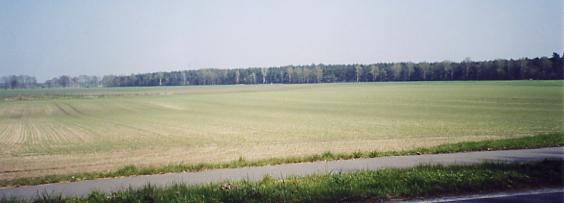
(picture descriptions are under the photos).

The fields surrounding Westervesede are nearly identical to the ones surrounding Westertimke, since they are only about 18 miles apart. The wooded areas, a mix of coniferous and deciduous trees, are used for hiking and birdwatching. The world's largest bird park is only about 30 miles away.
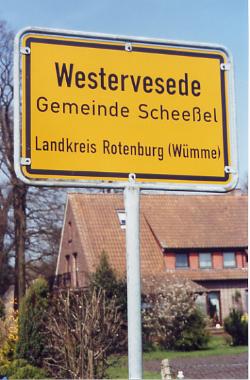
The entry to Westervesede shows that it belongs to the community of Scheeßel, which is in the district of Rotenburg. "Vesede" is the name of a small creek that runs nearby, and small villages grew up on both the west and east sides.
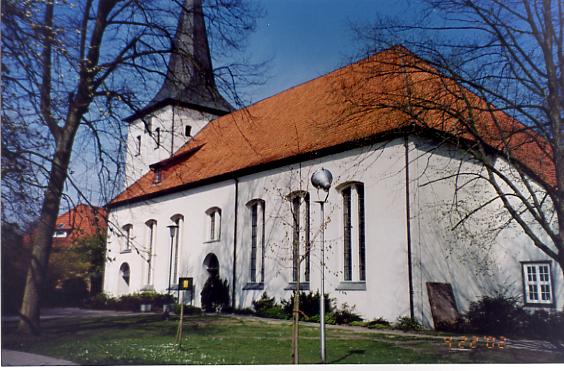
The church in Scheessel is used by residents of Westervesede and Ostervesede. It is called "St. Lukas-Kirche", or St. Luke's Church. One earlier church was burned down in the 30-years war (1618-1648). Its replacement was just not big enough for the population growth following that war, so it was torn down in 1755 and the church shown above was completed on St. Michaels Day (September 29) in 1758. This is the first time an organ was included (the current organ is about 30 years old).
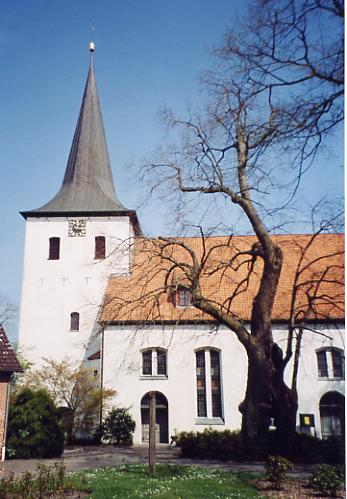
The church now employs three pastors - it serves a large community, and attendance is about 1000 every Sunday. Pastor Brunkhorst gave me a tour of the building, including up into the bell tower. The 17th century church bells were removed in early wars to be melted down for cannon, but one was later found in hiding and installed in the church cemetery (a few blocks south). The bells which now ring every hour, heard throughout the town and local farms, were cast in the late 19th century. The casting includes the name of the pastor at the time. The clockworks are still the original, keeping time since 1688! I was impressed at how new the clockworks appeared.
The large tree is the oldest in Scheeßel, and now has several iron bars holding the trunk together. It was used as a meeting place for centuries.
The outside of this church is not too different than the one in Kirchtimke - but as the next photos show, the interior is completely opposite!
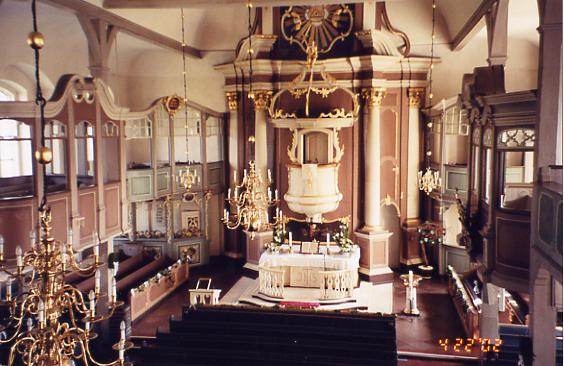
The front of the church, taken from the back balcony, shows the altar, the side pews, the elevated pulpit, and special balconies all around. Many years ago, each family would have an assigned pew. The rich or politically important were assigned to the balconies. The balconies are engraved with the initials of the first occupants. Note the elaborate and detail work everywhere, in contrast to the simplicity of the Kirchtimke Lambertuskirche! The Bruns family ancestors probably sat in the pews.
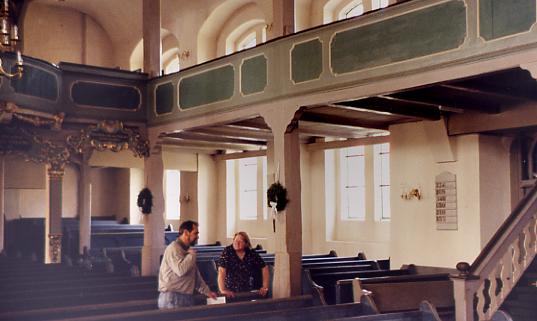
The pews were replaced in 1955. The seat depth now accomodates people of the 20th century. One of the old pews is shown in brown above, under the board which shows the hymns. That pew has seats only about 12" deep, and Pastor Brunkhorst (talking to Carol) says he has to use another one like this near the altar, and it gives him back pains to sit on it!
Pastor Brunkhorst told us that the church is virtually unchanged since it was built, except for the new pews and a new coat of paint or two. Sometime around 1940 the crucifix was moved from the upper pulpit to the altar, but otherwise, this is the same church that all of our Bruns ancestors used for their baptisms, weddings, and funerals.
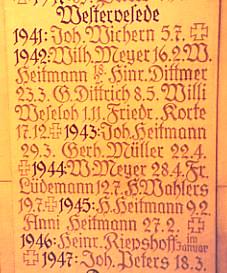

In a side room, now used by the youth group, is a set of war memorials in stone, with family names. Westervesede's fallen include several HEITMANNs, and the village of Westeresch (about 1 mile away) has one BRUNS.

All over town there are signs advertising potatoes for sale. This is one of the larger stands, self-service style. The signs refer to different types of potatoes; Cilena, Leyla, Hansa, Simone, Satina, and Laura. Potatoes are offered on every restaurant menu. On a private home between Westervesede and Ostervesede is a large, very old corn crib (see the Westervesede web page), so this is also an important local crop. Westervesede is also served by a volunteer fire department.
One of the more interesting local foods is available only in the winter months; "Kohl and Pinkel". We were told that a number of people get together on "Kohl and Pinkel" tours, where they spend all day going from village to village in the Bremen area, sampling the local Kohl and Pinkel at the various restaurants! A more detailed description, in English, of Kohl and Pinkel, and Bremen in general, is on this link: http://www-user.uni-bremen.de/~iaeste/Sommerheft.html#Flood
(click here to the Lambertus page or the Kirchtimke page)
Links to other Stellar Products pages: